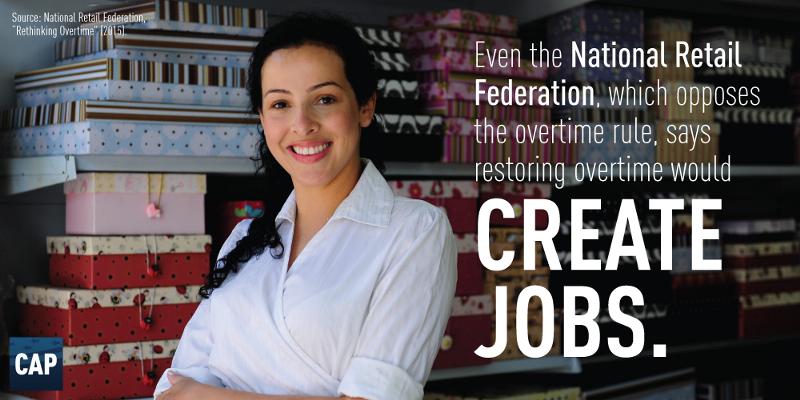This column contains an update.
Last week, the Department of Labor finalized changes to the country’s overtime laws — a move that will directly benefit millions of hard-working Americans by raising the overtime salary threshold. The new overtime rule doubles the current salary threshold under which salaried workers are guaranteed overtime — from $23,660 to $47,476. That means that workers earning under the new threshold will be guaranteed time and a half pay for every extra hour they work over 40 hours a week.
The new rule will benefit the middle class and in turn help the whole economy and create jobs. In fact, even a study commissioned by the National Retail Federation (NRF), a retail trade association that opposes the new overtime rule, found that the rule would create 117,000 new jobs.

After the announcement of the rule, CAP Action pointed to NRF’s study as evidence of its economic benefit. NRF took issue with that claim and responded with a blog post arguing that those new jobs will only come at the expense of existing employees.
But an examination of the NRF’s own study on the overtime rule disproves that very argument. As a result of the new overtime rule, some companies may cap existing salaried employees’ hours at 40 a week and create thousands of new part-time jobs to cover the extra work. These new part-time jobs will not come at the cost of existing employees — they will be created in addition to the existing salaried workers. As NRF’s study says, “In addition, some amount of new part-time positions would be created and filled.”
In other words, if you are a salaried worker at a business that decides to cap existing employees’ hours at 40 a week and hire part-time workers in response to the rule, you no longer will have to work extra hours for no extra pay. Instead, you will have more time to spend with your friends and family or on other things like professional development. And as a bonus to the whole economy, your employer may create new jobs.*
NRF also claims that employers will cut base pay in order to afford the new overtime rule. But the organizaiton is leaving out the extra overtime those workers are expected to earn. Indeed, the NRF itself says: “the analysis found that most employees would not actually see a change in net pay. Instead, many employees would see their hours reduced so that overtime would not be worked, while others would see their base wages, benefits or bonus pay decreased in order the offset the added payroll expense.”
Additionally, previous studies on the overtime rule show that while some employers may end up reducing base pay slightly, they will still end up increasing pay overall. A study by Anthony Barkume of the Bureau of Labor Statistics suggests that overtime reform would produce an “increase in labor earnings and reduced overtime use.” The new overtime rule would increase costs for companies if they have to raise pay or hire more workers. Many employers will respond by finding ways of using their employees’ 40 hours more efficiently, reducing the need for overtime.
Another misleading claim by NRF centers on who would benefit from the rule. In the blog post, NRF claims that groups supporting the overtime rule promise that it will raise wages for millions of Americans, and then cite the fact that millions of workers newly eligible under the recent overtime rule do not currently work more than 40 hours.
It is true that many of the 4.2 million Americans who will now be covered by overtime protections may not currently work overtime and therefore may not see a raise. But they also won’t have to worry about being forced to work extra hours uncompensated.
NRF’s analysis begs the question: if the impact of restoring overtime is so small, then why are the NRF and other trade associations so deeply opposed to the rule? The new overtime rule will extend overtime protections to millions more hard-working Americans with the added benefit of putting more money in the pockets of some and creating new jobs for others.
* Update, February 23, 2023: This column was updated to remove a link to a YouTube video from the U.S. Department of Labor that has since been taken down.